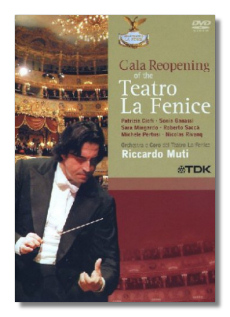
The Internet's Premier Classical Music Source
Related Links
- Latest Reviews
- More Reviews
-
By Composer
-
Collections
DVD & Blu-ray
Books
Concert Reviews
Articles/Interviews
Software
Audio
Search Amazon
Recommended Links
Site News
 DVD Review
DVD Review
Gala Reopening of the Teatro La Fenice

- Ludwig van Beethoven: Overture "Consecration of the House" Op. 124
- Igor Stravinsky: Symphony of Psalms
- Antonio Caldara: Te Deum
- Richard Wagner:
- Kaisermarsch
- Huldigungsmarsch
Patrizia Ciofi, Sara Allegretta, sopranos
Sonia Ganassi, Sara Mingardo, mezzo-sopranos
Roberto Saccà, Mirko Guadagnini, tenors
Michele Pertusi, Nicolas Rivenq, basses
Orchestra & Chorus of the Teatro del Fenice, Venice/Riccardo Muti
TDK DVD DVCORLF 66min Dolby Digital, DTS LPCM Stereo Full Screen
This interesting but somewhat odd concert was taped on December 14, 2003 to celebrate the reopening of Venice's rebuilt La Fenice. In English, the theater's name is "The Phoenix"; this is ironically appropriate because the theater burned to the ground twice in its history: the first time in 1836, and again in 1996. "Why not celebrate the reopening of an opera house with an opera?" one might legitimately ask. The answer is simply that, although the auditorium and the stage proper were complete, the stage equipment would not be ready for several months more. (The rebuilding process was marred by a series of legal problems, which explains why more then eight years were required to complete the reconstruction.)
Nevertheless, a concert of operatic arias and scenes, or a complete concert performance would not have been impossible, of course. Instead, conductor Riccardo Muti chose a program of a different sort. After leading those assembled in the Italian national anthem, Muti presents Beethoven's Consecration of the House Overture, a reasonable enough choice for the occasion, except it is not one of the composer's best works. The rest of the music is associated with Venice in one way or another. Stravinsky loved "La Serenissima" and wrote several works for it – but not, it must be said, the Symphony of Psalms, which was written for the Boston Symphony Orchestra! Stravinsky is buried in Venice, however. Wagner actually died there, although it is questionable how much the two marches included here have to do with Venice. (The Kaisermarsch even includes a quote from "Ein feste Burg ist unser Gott.") Antonio Caldara (1671-1736) was born in Venice, although he spent much of his career in Vienna. And so it goes. Presumably the Caldara was programmed in order to give eight fine operatic soloists to do, although the work is barely ten minutes long, so they don't get to do much!
I guess this is a DVD one purchases to celebrate the occasion; the only masterpiece here is the Stravinsky, which is performed well, but without the crispness it seems to require. (The choral singing is lovely, though.) The Caldara is something of a tease. About the Beethoven and the Wagner, one can say that the musicians try and almost succeed to make a silk purse out a sow's ear. I'm not sure that eschewing the incipient vulgarity of the two marches by Wagner is entirely a good thing, though!
The sound (stereo, Dolby Digital 5.1, or Dolby Surround 5.1) and picture (4:3 aspect ratio) are excellent. There are no bonus features. Your move.
Copyright © 2005, Raymond Tuttle




















